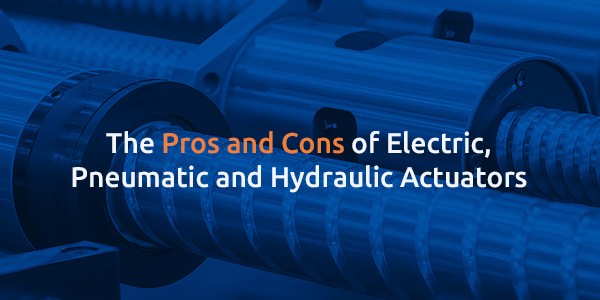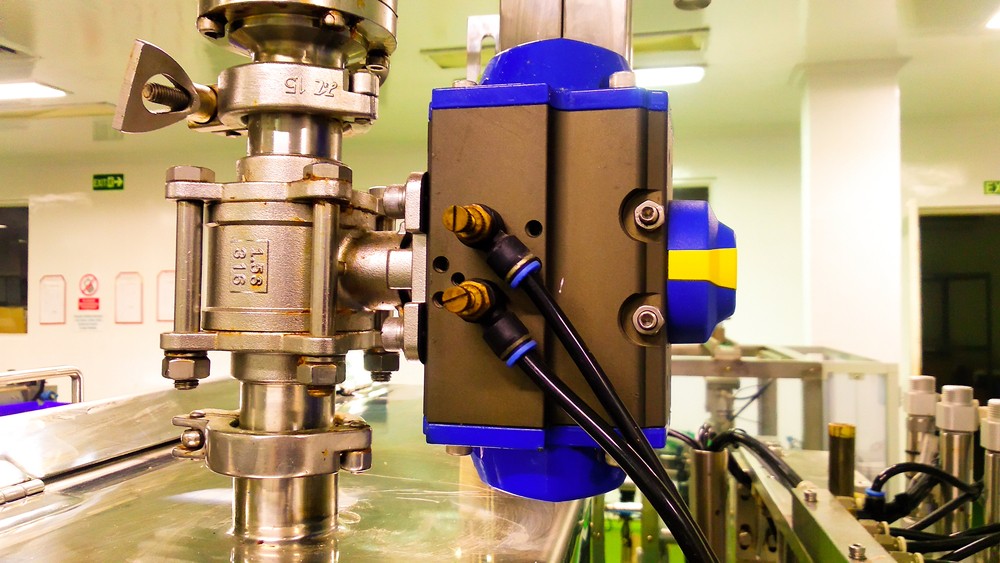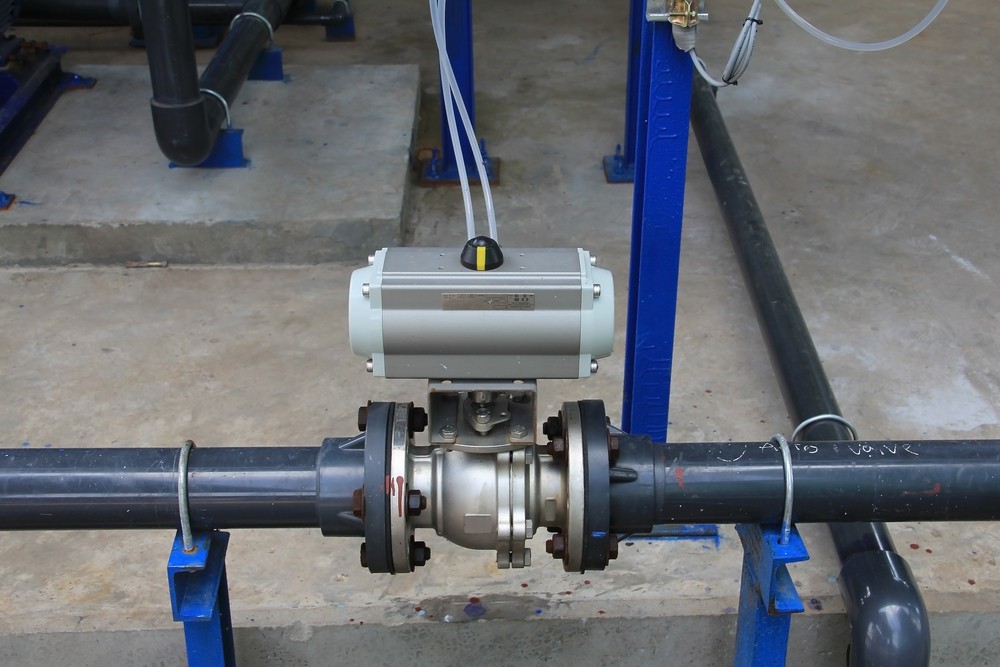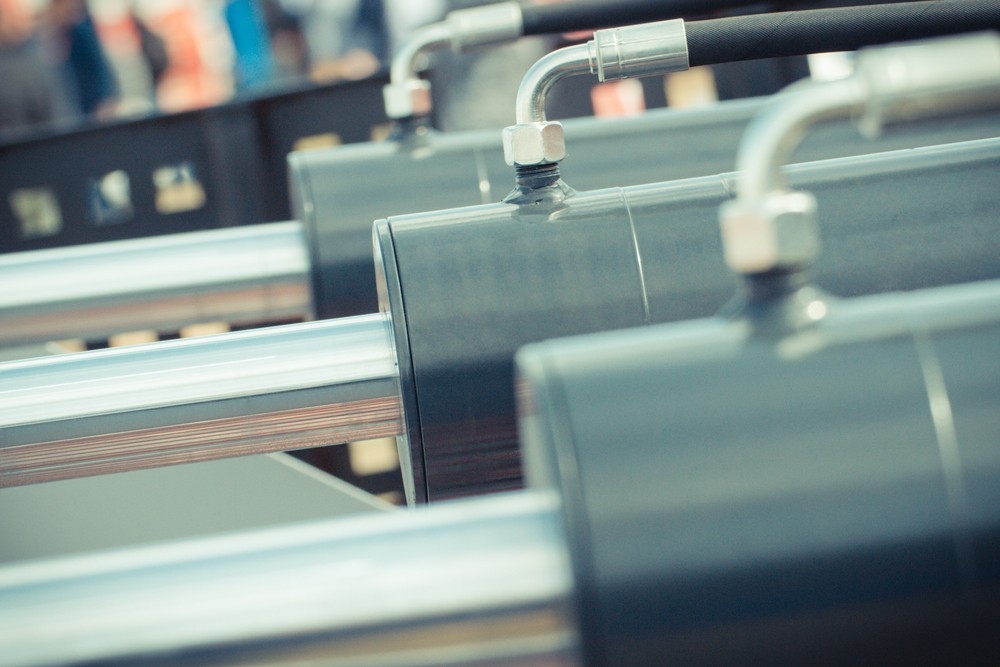The Pros and Cons of Electric, Pneumatic and Hydraulic Actuators

Breaking Down the Different Types of Actuators
Manufacturers have a choice of power options for machine and equipment operation. Electric, pneumatic and hydraulic actuators are all viable modes for delivering supreme force, but it’s not always clear which solution is ideal. Manufacturers must choose their actuator setup according to their specific application requirements — which requires a clear understanding of what makes one mode more applicable than another.
What are the pros and cons of electric, pneumatic and hydraulic actuators? How do they differ, and what makes them applicable in different scenarios?

What Is an Electrical Actuator?
An electrical actuator is a mechanical device that combines a servo motor with worm gear. This setup prevents an unbalanced load from causing a reversal of the drive direction. An electric drive controls the motor, enabling the variance of the rotation speed. The motor’s power determines the amount of torque the actuator delivers.
Electrical actuators use motion to convert electricity into kinetic energy. Manufacturers looking for precision will find great results with electrical actuators. They allow for full control of motion and offer much easier modulation of energy than fluid power. Electrical actuators are also easy to network and program — allowing for quick feedback and diagnostics. They’re also the quietest option.
On the con side, electrical actuators are usually more expensive than pneumatic and hydraulic equipment. They’re also large and bulky — depending on the application — and may present electrical and flammable hazards if kept in volatile environments.
Key takeaways:
- Highest precision controls and quietest function
- Easily programmed and calibrated for unique applications
- Higher cost than hydraulic or pneumatic options
Types of Electrical Actuators
Electric actuator examples include rotary versions that open and close via butterfly, plug and ball valves. The motor delivers electromagnetic power that creates rotation, enabling numerous stops during each stroke. A table or a circular shaft acts as the rotational element. Key considerations when choosing these types of electric actuators are the device’s torque and range of motion.
A linear electric actuator works via a motor-driven screw assembly or ball screw. These devices open and close with angle, gate, pinch, diaphragm or glove valves. An unsupported end of a screw, which can be gear-, belt- or direct-driven, serves as the load’s attachment point.
What to Consider With Electrical Actuators
Choosing an electrical actuator requires an assessment of several key parameters, including load, speed, duty cycle and available space.
These devices work best in certain applications. Examples include the automotive industry for driverless vehicles and manufacturing processes like gluing, welding and riveting. The food and beverage industry also uses them for manufacturing PET bottles, labeling and filling systems, and robotic equipment.

What Is a Pneumatic Actuator?
A pneumatic actuator is a device that converts energy into mechanical motion. Many industries rely on this equipment for applications requiring the opening and closing of valves. They’re a good choice for tasks that involve fitting to angle seat control valves designed for high-pressure steam applications.
Pneumatic actuators use the extension and retraction of a piston rod to convert compressed air into linear force. They feature a simple design, and since they use air as opposed to fluids or electricity, they are usually safer to operate and easier to repair. Pneumatic actuators are often the cheaper option — making them a good option for those on a strict budget.
Pneumatic actuators require proportional sizing for all valves, regulators and compressors. This makes using them for specific jobs a bit complex. Contamination by lubrication — which can lead to extended downtimes — is also a possibility with pneumatic actuators, and they aren’t as capable as similar devices due to pressure losses.
Key takeaways:
- A simple function that’s easy to assemble and maintain
- Useful in hazardous areas where electric and hydraulic options aren’t suitable
- Requires a high degree of customization for each application
Types of Pneumatic Actuators
The spring/diaphragm version is the most common type of pneumatic actuator for operating industrial process control valves. It consists of a diaphragm and a plate connected to a stem. Applying pressure to the diaphragm enables pneumatic pressure to enter the housing, causing the retraction of a spring. Rearranging the pneumatic supply results in a fail-open or air-close when a pressure loss occurs.
Pneumatic actuators can be linear or rotary. A linear model moves in a straight line, such as when a rod moves in and out of a cylinder. A rotary actuator can make objects move in a circular motion.
What to Consider With Pneumatic Actuators
When choosing a pneumatic actuator, you’ll need to consider the appropriate directional force for your needs. Do you require motion in one direction or in an up-and-down or back-and-forth manner? You’ll also need to determine the actuator’s stroke length by assessing the distance you need the load to move.

What Is a Hydraulic Actuator?
A hydraulic actuator is a cylindrical tube and piston assembly that relies on hydraulically generated power to produce linear, rotary or oscillatory movement. This motion can operate a wide range of mechanical systems in various equipment and machinery, such as presses, excavators, skid steer loaders and cranes.
Hydraulic actuators use pumps of incompressible oil to power their systems. It’s possible to customize hydraulic actuators to handle almost any amount of force — which makes them the strongest available option. These devices produce high speeds and hold a constant force without requiring more liquid.
One of the main disadvantages of hydraulics is their high maintenance and constant monitoring requirements. Hydraulic actuators also need additional parts, including pumps, motors, a fluid reservoir and more — all of which require their own upkeep and maintenance.
Key takeaways:
- Great for high-speed, high-pressure applications
- Ability to hold a constant force based on the fluid used in the application
- Require a high level of maintenance and oversight to maintain
Types of Hydraulic Actuators
A single-action unit is one common hydraulic actuator type. Also known as displacement cylinders, these models apply pressure to one side of the piston. Gravity or a spring is required to provide a return stroke for the piston. A double-action actuator applies pressure on both sides of the piston. The distance in pressure between both sides determines the side to which the piston moves.
Other hydraulic actuator classifications include linear and rotary, which refers to the specific type of motion required. A telescopic actuator is the best option for applications requiring longer strokes and smaller retracted cylinder lengths.
What to Consider With Hydraulic Actuators
While hydraulic actuators perform well in many situations, they often require the installation of complementary parts. Examples include fluid reservoirs, release valves, heat exchangers, pumps and motors.
What’s the “best” option?
Each type of actuator comes with its own pros and cons. Choosing the right one depends on the specific demands of each power application and the operating environment. Consider the pros and cons of each power mode carefully. To choose the right one, factor in budget, scalability, and maintenance requirements as well.